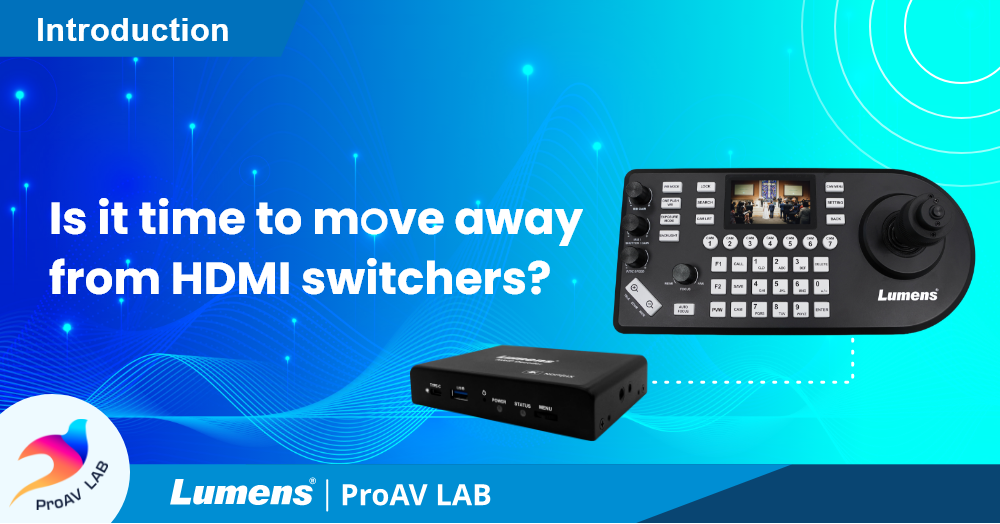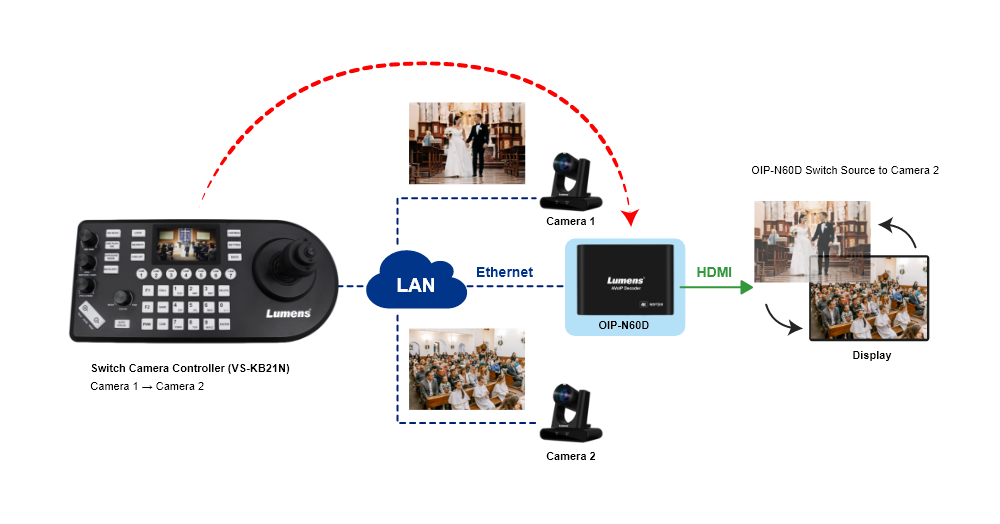Is it time to move away from HDMI switchers?
Written by Kieron Seth, Product Marketing Director at Lumens
March 27, 2024 15342

There are a lot of four channel HDMI switchers on the market and they are deservedly popular both in AV installations and live production. Connect HDMI cameras, media players and laptops to the switcher and with the press of a button you can mix sources or simply switch inputs – it's high quality and there's virtually no delay.
AV installations that need to change the video output to local monitors depend on HDMI switchers in environments such as bars, control rooms and board rooms. HDMI switchers are also widely used in live productions by vloggers, houses of worship and sports clubs for example.
There are real benefits to using HDMI switchers, such as the low initial cost, the ease of use, the potential for high quality video and the speed of switching between channels. However, HDMI has its limitations:
01.
HDMI cables are severely length limited. Typically, they do not exceed 5m, while extended optical models are rare and very expensive.
02.
Inexpensive HDMI switchers generally operate on a single frequency, meaning that you cannot use a variety of formats (720P, 1080P 30, 1080P 60 and 2160 30 for example) in the same production: you usually have to choose a single standard and stick to it.
03.
A 4-channel switcher is a fixed hardware configuration – it's not designed to expand to offer you say 6, 8 or 12 channels. It's simply a case of throwing out the old model and replacing it with a bigger unit if you need more inputs.
04.
As the AV and media world transitions to IP, NDI and Dante AV-H streaming formats, HDMI switchers are unable to accept these new popular formats.
05.
An HDMI switcher has a single purpose. It cannot control cameras, or route signals over IP network.
The Lumens Stream Select system is a new generation IP switching system. It's based around the VS-KB21 controller which allows the user to control every camera on the local network. Change the camera angle, trigger camera movements, switch to new preset positions, and zoom in on any subject. With Lumens Stream Select, it's fast, intuitive and familiar. The VS-KB21 also has a live preview screen to monitor each camera which is an incredibly convenient feature.
Unlike other camera controllers, VS-KB21 can pair with the OIP-N60D decoder to create a video switching system, called Stream Select. With the touch of a button, the controller instructs the decoder to output the selected IP stream. It's a solution that has a great deal of potential.

01.
The IP controller can see, manage and control over 200 cameras on the local IP network. This overcomes the inherent limitation of HDMI switchers.
02.
The system is not limited by cable length – the controller, decoder and cameras can reside anywhere on the local LAN.
03.
The system can work with a variety of streaming formats, depending on the licences installed. These can include RTSP, NDI HX and Dante AV-H.
04.
The cost is very attractive, especially when considering that the system includes remote camera control.
05.
Flexible installation: unlike traditional equipment, the Lumens solution can run entirely on PoE (power over Ethernet), meaning that all units are powered by the very network they are installed on, with no need for external power adapters.
06.
AV managers can remotely manage all elements of the workflow using the easy-to-use web interface, or the Windows-based Deployment Tool 2.0 which enables fleet management of multiple cameras.
07.
Not only does the system output video to HDMI, but it also generates a USB stream which is compatible with all leading video conferencing systems, making Stream Select a valuable addition to the unified communications toolkit.
With Lumens Stream Select, the essentials of IP switching are already in place and can deliver excellent results. HDMI technology, however, is mature and well-featured and still offers some advantages. In the very near future, IP technology (usually thru firmware upgrades) will see these advantages all but disappear: switching times will reduce to rival those of HDMI and the decoder will be able to offer picture in picture and other creative video effects.
Click here Back to Top ↑
